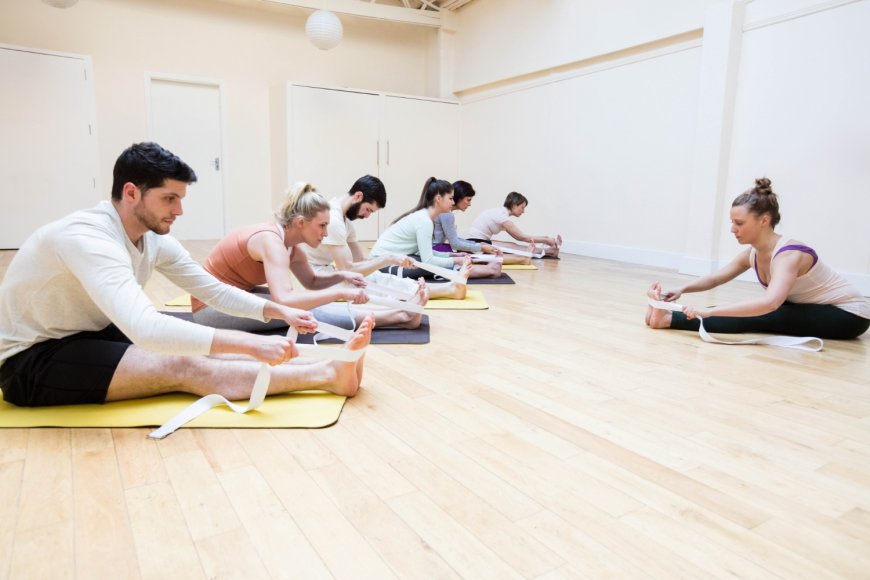The Difference Between 200-Hour and 300-Hour Yoga Teacher Training Programs
Discover the key differences between 200-hour and 300-hour yoga teacher training programs to choose the right path for deepening your yoga journey and teaching skills.

If you're passionate about yoga and eager to deepen your practice, taking the next step with a Yoga Teacher Training (YTT) program can be a transformative experience. Deciding between a 200-hour and a 300-hour yoga teacher training program is a common dilemma for yoga enthusiasts and aspiring teachers. Both offer invaluable insights and skills, yet they serve different purposes and are structured to meet different needs. In this guide, we’ll explore the distinctions, so you can make an informed choice that aligns with your personal and professional yoga journey.
What Is a 200-Hour Yoga Teacher Training Program?
The 200-hour yoga teacher training program is considered the foundation of YTT. It's often the first step for individuals looking to teach yoga or simply deepen their own practice. Here are some highlights:
Core Structure and Focus
A 200-hour yoga teacher training program covers the essentials of yoga philosophy, anatomy, alignment, and teaching methods. Most programs offer a well-rounded introduction to the fundamentals of yoga, with a blend of physical practice and theoretical knowledge.
Who Should Take a 200-Hour YTT?
The 200-hour program is ideal for:
-
Beginners seeking to understand the foundations of yoga.
-
Practitioners who want to advance their personal practice.
-
Aspiring teachers who want to start teaching basic yoga classes.
Key Benefits of a 200-Hour Yoga Teacher Training
-
Comprehensive Introduction: This program is designed to introduce you to the world of yoga, covering essential topics like asanas (poses), pranayama (breathing exercises), meditation, and basic anatomy.
-
Basic Teaching Skills: Participants gain foundational teaching skills that prepare them to lead beginner-friendly classes confidently.
-
Personal Growth and Self-Discovery: Many students find that the program offers personal transformation and helps them develop a deeper connection to themselves and their practice.
-
Recognition and Certification: Upon completion, graduates receive a certificate, often recognized by organizations like the Yoga Alliance, qualifying them to teach yoga classes.
-
Flexibility in Learning: Many 200-hour yoga teacher training programs are offered both in-person and online, providing flexibility for students to learn in a way that best suits their lifestyle.
What Is a 300-Hour Yoga Teacher Training Program?
Once you’ve completed a 200-hour program and gained some teaching experience, the next step is often a 300-hour yoga teacher training program. This advanced course is designed to deepen your understanding of yoga, both as a personal practice and as a teaching methodology.
Core Structure and Focus
The 300-hour training program builds on the foundation established in a 200-hour course. It delves into advanced asana practice, yogic philosophy, anatomy, and specialized teaching techniques. You’ll often encounter a more focused curriculum that explores specific areas, such as restorative yoga, Ayurveda, or the subtleties of pranayama and meditation.
Who Should Take a 300-Hour YTT?
The 300-hour program is designed for:
-
Yoga teachers who want to deepen their knowledge and refine their teaching skills.
-
Practitioners who completed a 200-hour program and want to explore advanced yoga concepts.
-
Students looking to specialize in a particular style or area of yoga.
Key Benefits of a 300-Hour Yoga Teacher Training
-
Advanced Practice and Knowledge: The 300-hour program enhances your practice by diving into more advanced poses, breathing techniques, and philosophies. You'll explore topics that go beyond the basics, giving you a more nuanced understanding of yoga.
-
In-depth Anatomy and Physiology: A 300-hour training program provides more thorough insight into the body's structure, biomechanics, and how yoga impacts each body system.
-
Refined Teaching Skills: This course is designed to elevate your teaching skills. You'll learn to sequence classes creatively, teach various styles, and work with diverse student populations.
-
Specialization Opportunities: Many 300-hour programs offer opportunities to focus on specific types of yoga, such as therapeutic yoga, yin yoga, or prenatal yoga. This specialization can enhance your teaching portfolio and attract a wider range of students.
-
Deeper Spiritual Insights: Advanced yoga teacher training often includes more profound aspects of yoga philosophy, such as chakras, advanced meditation techniques, and the study of ancient yogic texts. This can help you cultivate a holistic approach to teaching and personal practice.
Side-by-Side Comparison of 200-Hour and 300-Hour Yoga Teacher Training Programs
|
Aspect |
200-Hour Yoga Teacher Training |
300-Hour Yoga Teacher Training |
|
Purpose |
Foundational knowledge and skills |
Advanced knowledge and teaching skills |
|
Prerequisites |
None; open to all levels |
Requires 200-hour certification |
|
Duration |
Typically 4–6 weeks (intensive) |
6–12 weeks (intensive or part-time) |
|
Curriculum Focus |
Basics of asanas, philosophy, anatomy |
Advanced asanas, philosophy, anatomy |
|
Specialization |
General focus |
Offers options for specialization |
|
Teaching Level |
Prepares for teaching beginners |
Prepares for teaching intermediate-advanced students |
|
Yoga Alliance Recognition |
RYT-200 |
RYT-500 (upon completion) |
Choosing the Right Program for You
The choice between a 200-hour and 300-hour yoga teacher training program depends on your experience level, goals, and aspirations as a teacher or practitioner.
-
If You’re New to Yoga: The 200-hour program is a great starting point. It provides a solid foundation, familiarizes you with yoga principles, and equips you with the confidence to lead a class.
-
If You’ve Completed a 200-Hour YTT: If you've already completed a 200-hour program and feel ready to deepen your practice, the 300-hour course can be an excellent way to advance your skills and knowledge.
-
If You Aspire to be a Specialized Yoga Teacher: A 300-hour yoga teacher training program often offers specialized training that can make you stand out in your teaching career. It’s a worthwhile investment if you want to focus on specific areas or styles within yoga.
-
If You’re Seeking Personal Growth: Many students enroll in yoga teacher training programs for personal development as much as professional training. Both the 200-hour and 300-hour programs offer profound learning opportunities and life-changing experiences.
Completing Both Programs: A Path to RYT-500
One benefit of completing both the 200-hour and 300-hour training programs is that you’ll achieve the RYT-500 designation through the Yoga Alliance. This designation not only demonstrates a high level of commitment and expertise but also opens up more teaching opportunities. It’s recognized internationally as a standard of excellence for yoga teachers.
Conclusion
Both the 200-hour and 300-hour yoga teacher training programs offer valuable, transformative experiences for anyone looking to deepen their knowledge, skills, and understanding of yoga. The 200-hour course is perfect for those starting their teaching journey or deepening their practice, while the 300-hour program offers a more advanced approach, ideal for teachers looking to specialize or refine their skills.
Whichever path you choose, remember that yoga is a journey, and each step brings you closer to the deeper knowledge and fulfillment that yoga offers. Whether you're just beginning or you're ready to advance, a yoga teacher training program can be a powerful tool in your personal and professional development as a yogi.
If you have questions about our yoga teacher training programs or need guidance on choosing the right course, we’re here to help! Reach out to the Salty Prana team, and we'll be happy to support you on your yoga journey.
FAQS
1. Do I need prior experience in yoga to join a 200-hour yoga teacher training program?
No, prior experience is not typically required to join a 200-hour yoga teacher training program. These programs are designed as foundational courses and are open to beginners as well as those looking to deepen their personal practice. The program covers yoga basics, teaching techniques, and foundational knowledge, making it an ideal starting point for anyone interested in yoga.
2. Can I take a 300-hour yoga teacher training without completing a 200-hour program first?
Generally, no. Most 300-hour yoga teacher training programs require that you have already completed a 200-hour YTT certification. This prerequisite ensures that participants already have a solid foundation in yoga principles and basic teaching methods, as the 300-hour program builds on these essentials and dives into more advanced practices and techniques.
3. What are the main career benefits of completing both the 200-hour and 300-hour yoga teacher training programs?
Completing both programs enables you to achieve the RYT-500 (Registered Yoga Teacher 500-hour) designation, recognized by the Yoga Alliance. This certification is highly respected and may expand your teaching opportunities, allowing you to lead advanced classes, workshops, and even teacher training programs. The 300-hour program also allows you to specialize, making you more appealing to studios or clients seeking expertise in specific yoga styles or techniques.
4. How long does it typically take to complete a 200-hour and 300-hour YTT program?
The duration of each program can vary. Many 200-hour programs are intensive and can be completed in 4–6 weeks, though some are part-time and spread out over several months. Similarly, 300-hour programs may be offered as 6–12 week intensives or as longer part-time courses, depending on the format. Some schools also offer flexible options with weekend classes to accommodate working professionals.
5. Will a 300-hour YTT help me specialize in a particular style or focus of yoga?
Yes, most 300-hour YTT programs allow you to explore advanced concepts and often offer pathways to specialize in areas such as therapeutic yoga, Ayurveda, yin yoga, or restorative practices. This focus helps you hone your skills and gain expertise in specific areas, enabling you to tailor your classes and attract a wider range of students with unique needs or interests.
What's Your Reaction?



















